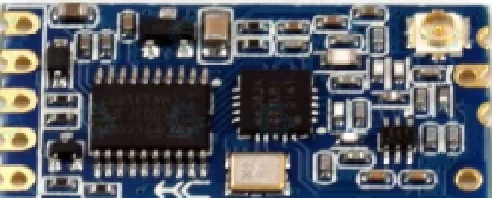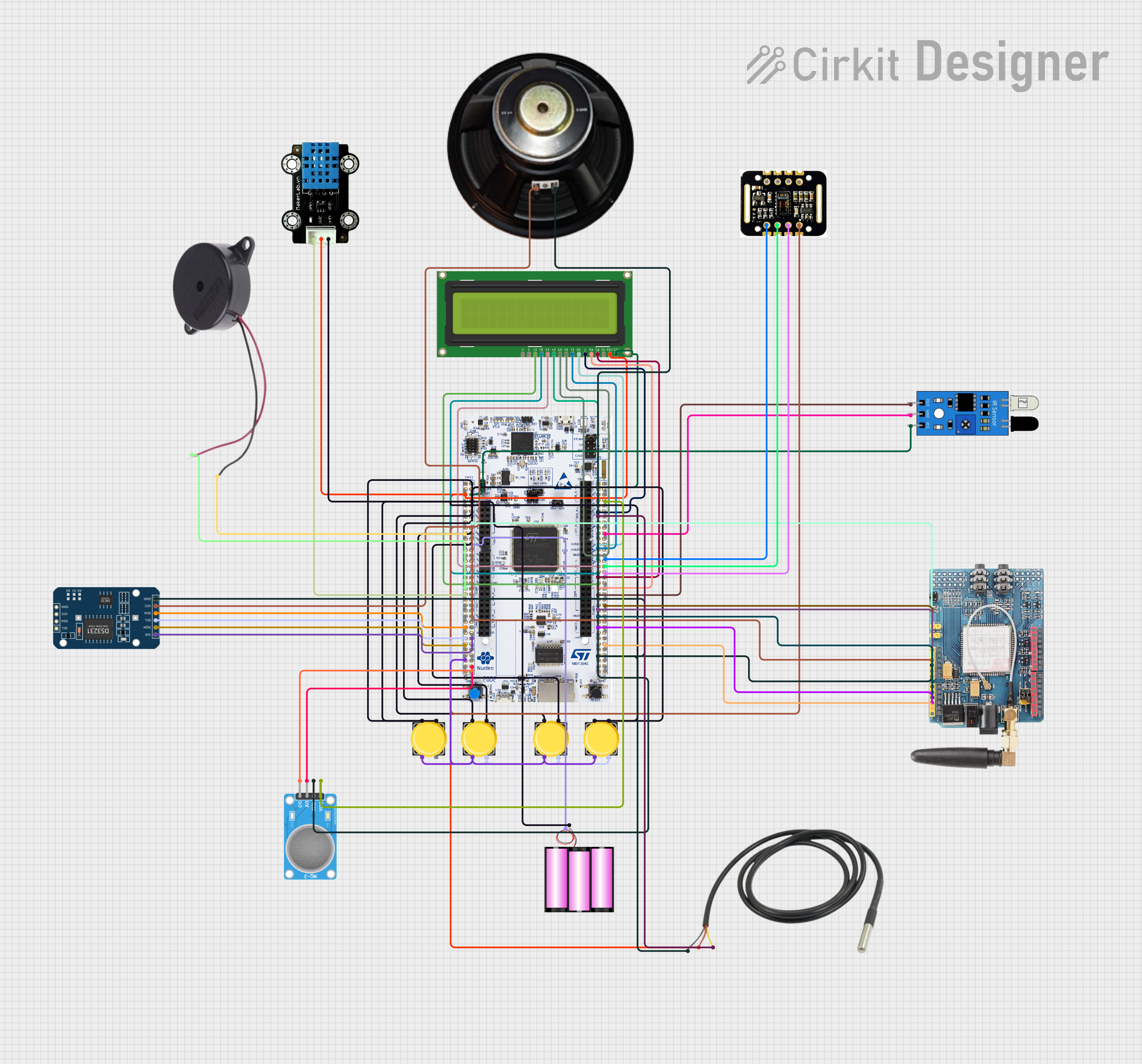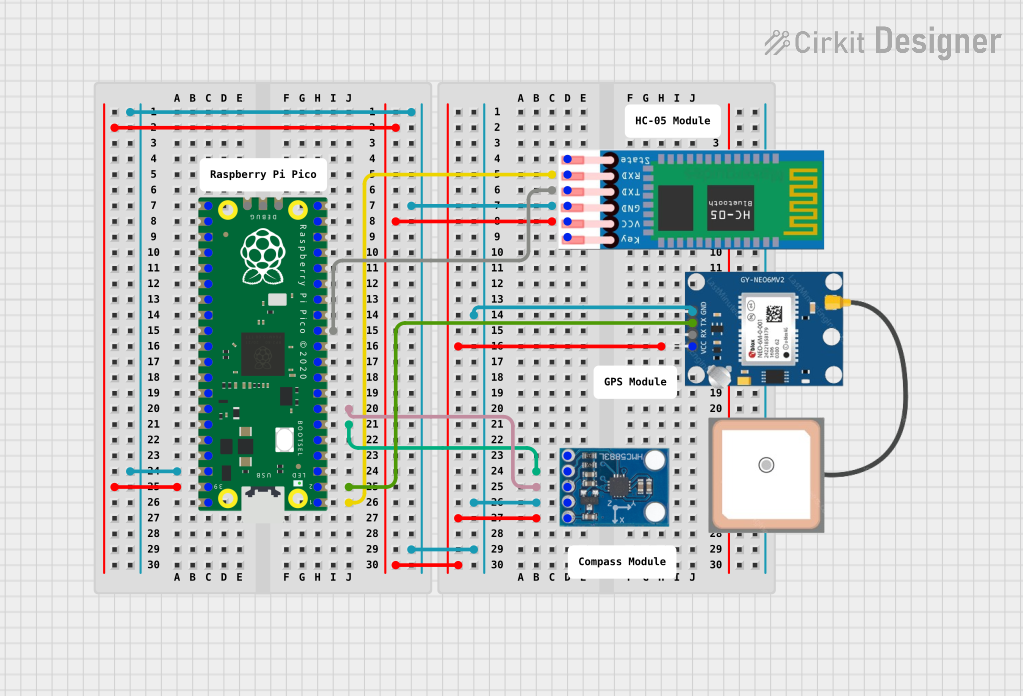
How to Use HC12: Examples, Pinouts, and Specs

 Design with HC12 in Cirkit Designer
Design with HC12 in Cirkit DesignerIntroduction
The HC12 is a low-cost, low-power, 12-channel RF transceiver module that operates in the 433MHz frequency band. It is widely used for wireless communication in applications such as remote control, data transmission, and sensor networks. The module is designed for ease of use, offering a simple UART interface for communication with microcontrollers and other devices. Its long-range capabilities and configurable settings make it a versatile choice for both hobbyists and professionals.
Explore Projects Built with HC12

 Open Project in Cirkit Designer
Open Project in Cirkit Designer
 Open Project in Cirkit Designer
Open Project in Cirkit Designer
 Open Project in Cirkit Designer
Open Project in Cirkit Designer
 Open Project in Cirkit Designer
Open Project in Cirkit DesignerExplore Projects Built with HC12

 Open Project in Cirkit Designer
Open Project in Cirkit Designer
 Open Project in Cirkit Designer
Open Project in Cirkit Designer
 Open Project in Cirkit Designer
Open Project in Cirkit Designer
 Open Project in Cirkit Designer
Open Project in Cirkit DesignerCommon Applications
- Wireless sensor networks
- Remote control systems
- Home automation
- Industrial monitoring
- Data logging and telemetry
Technical Specifications
The HC12 module is designed to provide reliable wireless communication with minimal power consumption. Below are its key technical details:
| Parameter | Value |
|---|---|
| Operating Frequency | 433.4 MHz to 473.0 MHz |
| Number of Channels | 12 |
| Modulation Type | GFSK (Gaussian Frequency Shift Keying) |
| Communication Interface | UART (TTL level) |
| Baud Rate | 1200 bps to 115200 bps (default: 9600 bps) |
| Operating Voltage | 3.2V to 5.5V |
| Transmit Power | Up to 100mW (20dBm) |
| Sensitivity | -117 dBm at 5000 bps |
| Range | Up to 1.8 km (in open space) |
| Current Consumption | 16 mA (transmit), 3.6 mA (receive) |
| Dimensions | 27.8mm x 14.4mm x 4mm |
Pin Configuration
The HC12 module has a total of 4 pins. The table below describes each pin:
| Pin | Name | Description |
|---|---|---|
| 1 | VCC | Power supply input (3.2V to 5.5V). Connect to a regulated power source. |
| 2 | GND | Ground. Connect to the ground of the circuit. |
| 3 | TXD | UART Transmit pin. Sends data to the connected microcontroller or device. |
| 4 | RXD | UART Receive pin. Receives data from the connected microcontroller or device. |
Usage Instructions
The HC12 module is straightforward to use and can be easily integrated into a circuit. Below are the steps and best practices for using the HC12:
Connecting the HC12 to a Microcontroller
- Power Supply: Connect the VCC pin to a regulated 3.3V or 5V power source and the GND pin to the ground.
- UART Communication: Connect the TXD pin of the HC12 to the RX pin of the microcontroller and the RXD pin of the HC12 to the TX pin of the microcontroller.
- Antenna: Attach an appropriate 433MHz antenna to the module for optimal range and performance.
Configuring the HC12
The HC12 can be configured using AT commands sent via the UART interface. For example:
- To set the baud rate to 9600 bps:
AT+B9600 - To set the module to channel 5:
AT+C005
Example: Using HC12 with Arduino UNO
Below is an example of how to use the HC12 module with an Arduino UNO for basic communication:
Circuit Diagram
- Connect HC12 VCC to Arduino 5V.
- Connect HC12 GND to Arduino GND.
- Connect HC12 TXD to Arduino RX (pin 0).
- Connect HC12 RXD to Arduino TX (pin 1).
Arduino Code
// Example code for using HC12 with Arduino UNO
#include <SoftwareSerial.h>
// Define HC12 RX and TX pins
SoftwareSerial HC12(10, 11); // HC12 TX to pin 10, HC12 RX to pin 11
void setup() {
Serial.begin(9600); // Start serial communication with PC
HC12.begin(9600); // Start serial communication with HC12
Serial.println("HC12 Test");
}
void loop() {
// Check if data is received from HC12
if (HC12.available()) {
String receivedData = HC12.readString(); // Read data from HC12
Serial.print("Received: ");
Serial.println(receivedData); // Print received data to Serial Monitor
}
// Check if data is sent from Serial Monitor
if (Serial.available()) {
String sendData = Serial.readString(); // Read data from Serial Monitor
HC12.print(sendData); // Send data to HC12
}
}
Best Practices
- Use a regulated power supply to avoid damaging the module.
- Ensure proper antenna placement for maximum range.
- Avoid placing the module near sources of interference, such as motors or high-frequency circuits.
Troubleshooting and FAQs
Common Issues
No Communication Between Modules
- Cause: Mismatched baud rates or channels.
- Solution: Ensure both modules are configured with the same baud rate and channel using AT commands.
Short Communication Range
- Cause: Poor antenna connection or interference.
- Solution: Check the antenna connection and ensure there are no obstacles or interference sources nearby.
Module Not Responding to AT Commands
- Cause: Incorrect wiring or baud rate.
- Solution: Verify the wiring and ensure the baud rate matches the module's default (9600 bps).
FAQs
Can the HC12 operate at 5V?
- Yes, the HC12 supports an operating voltage range of 3.2V to 5.5V.
What is the maximum range of the HC12?
- The HC12 can achieve a range of up to 1.8 km in open space with a proper antenna.
How do I reset the HC12 to factory settings?
- Send the
AT+DEFAULTcommand via UART to reset the module to its default settings.
- Send the
By following this documentation, you can effectively integrate and troubleshoot the HC12 module in your projects.